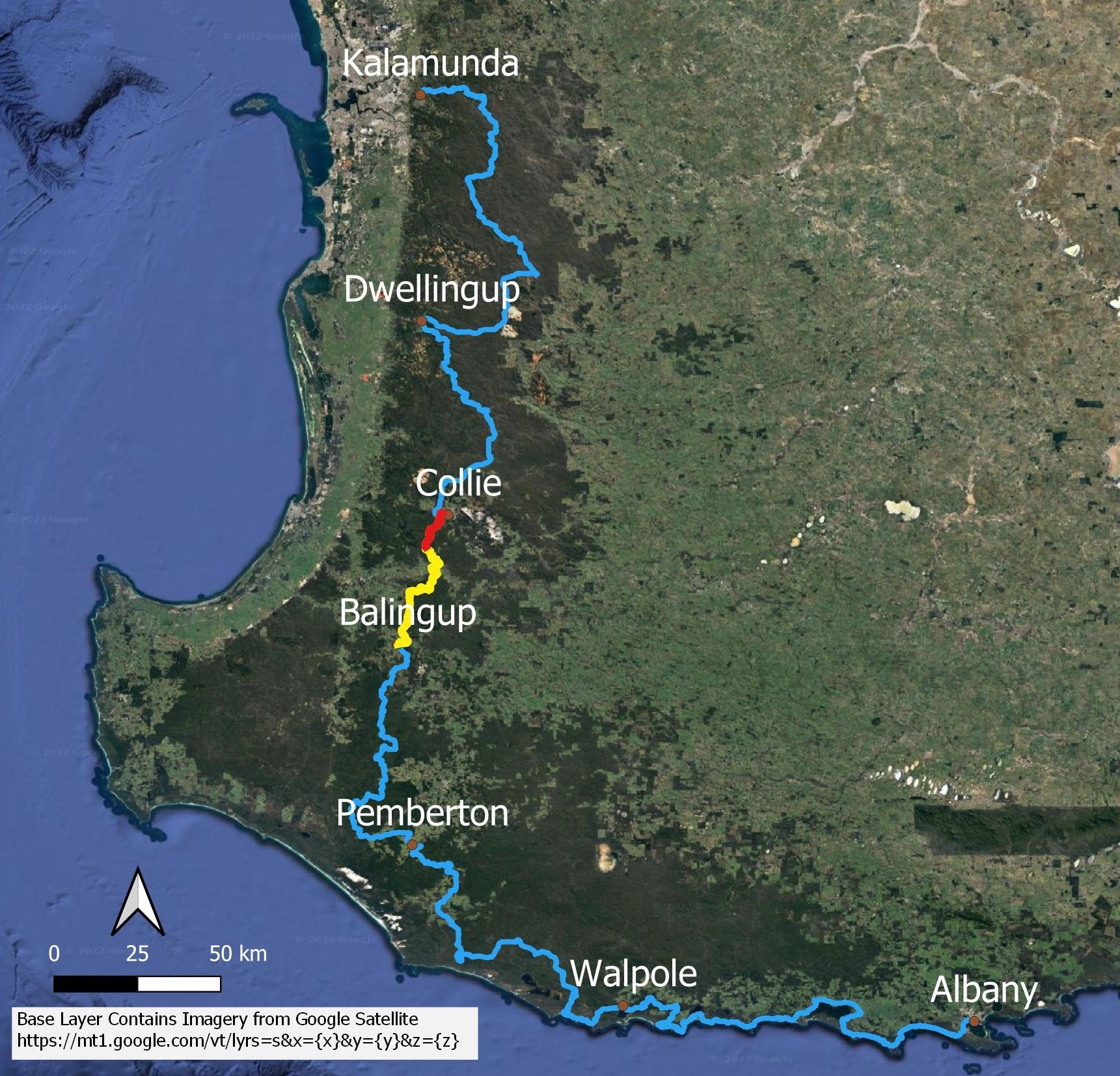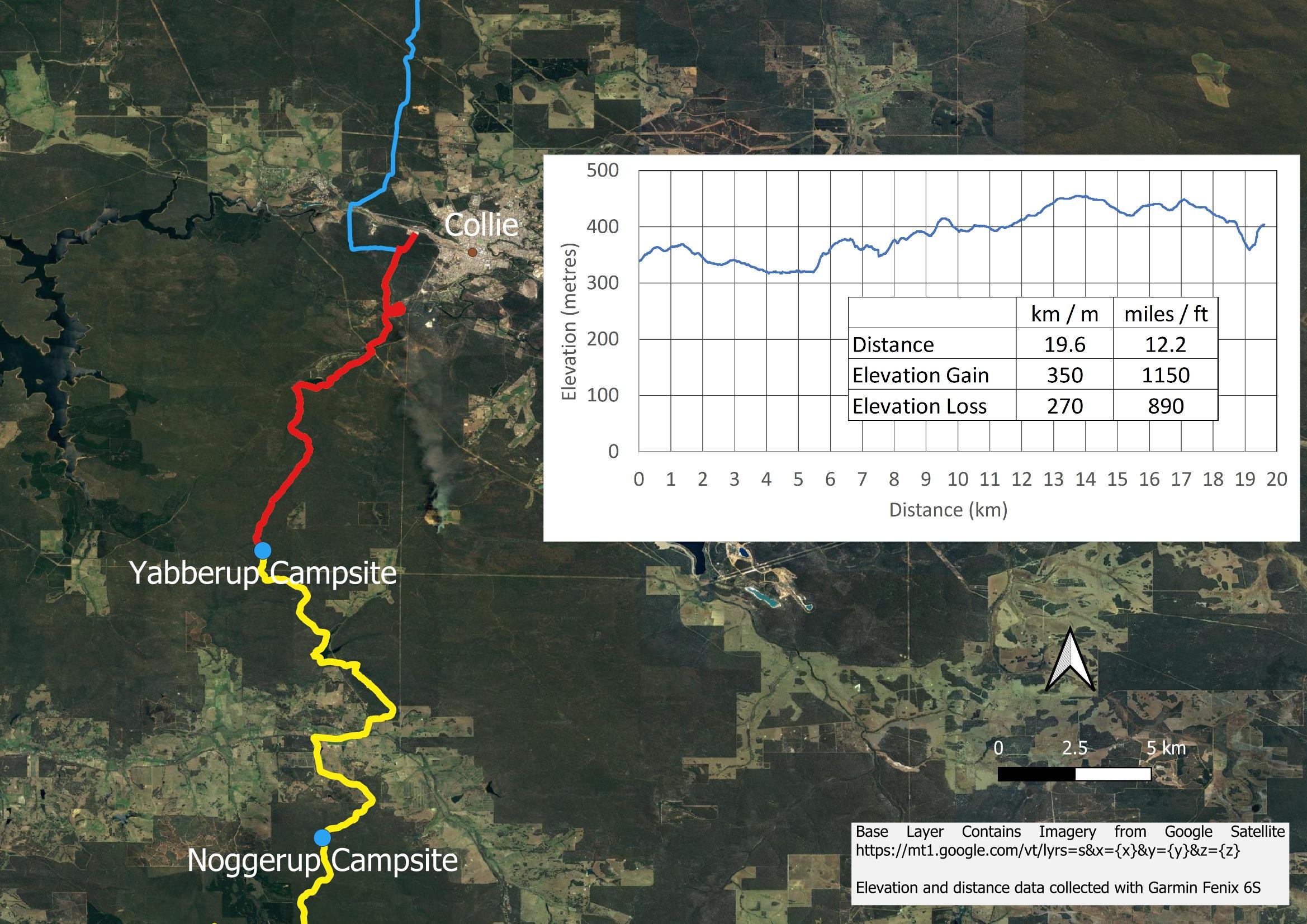Day 27: Collie to Yabberup
We acknowledge the Nyoongar People as the traditional custodians of the land and waters along the Bibbulmun Track
By their very nature, thru-hikes have a rhythm, an ebb and flow in terrain, weather, season, vegetation and wildlife. The changes are gradual as you pass through the landscape on foot, but part of the joy is noticing them. And no thru hike of 1,000 km is spectacular every single day, because we become accustomed to spectacular and it thence ceases to be so. Better to simply relish each day, whatever it may be, and find joy in the small moments, rather than waiting for something ‘better’.
The section between Collie and Balingup is lovely walking: not spectacular, or with expansive views, but with numerous pretty vistas and vignettes to surprise and delight, including a banner moment I’ll remember for the rest of my life. Wildflowers and birdlife are exceptional and, if you’re interested in either, you’ll love this section!
Collie to Yabberup overview map
We highly recommend that north to south wildflower enthusiasts who catch a taxi to bypass the spur trail get dropped off at the cemetery on Coalfields Rd east of town, rather than at the usual spot near the bridge on Mungallup Rd south of town. A track heading south from the eastern side of the cemetery passes through the park and joins the spur trail. Turn right and in 100m or so you’ll be back on the track. (This is reflected in the above map). Otherwise you might miss a treat!
Here are just a few of the orchids we saw in the park. First, different forms of pansy orchid (Diuris longifolia), including a leucistic one:
Diuris longifolia (Purple Pansy Orchid)
Diuris longifolia (Purple Pansy Orchid)
Diuris longifolia: a leucistic form
Just opening up, this Purple Pansy is intensely coloured
And hammer orchids (Drakaea livida). We’ve mentioned before that you’d imagine they’d be easy to spot from macro images, but the next shot gives you more of an idea of their tiny, cryptic nature:
We also saw Caladenia longicauda, C. discoides, Drakaea glyptodon, Pterostylis vittata, Cyanicula sericea, Caladenia macrostylis and Caladenia latifolia. Numerous Thelymitras were in bud and, for those who hike in autumn, Eriochilus leaves dot the path edges so there would be a good display then too.
Following the northern bank of the Collie River.
On the other side of the river is burnt country but, even though it’s jarrah, it’s quite different to that around Mt Wells further north. A carpet of cheerful Hibbertia lifts our spirits.
Lobelia rhombifolia is common in newly burnt terrain.
Pterostylis erubescens (Red Sepalled Snail Orchid): a new species of orchid to add to the growing tally!
Hibbertia hypericoides
Little Pink Fan (Caladenia nana ssp nana)
Then you’re out of the burnt area, with beautiful Thomasia grandiflora shrubs to cheer you on!
Mungalup Dam…
…But at least we can walk!
And then one of those completely unexpected, unforgettable banner moments. We’re walking through otherwise unremarkable forest when suddenly we are inside a cloud of heavenly perfume. The air is rich with an unmistakable citrus, honey, floral fragrance: it’s brown boronia (B. megastigma)! When I worked in a plant nursery, a single small pot with a dozen flowers would scent the entire entrance area. And now here we are, in a sheltered dell with not one but hundreds of full-grown plants and probably hundreds of thousands of flowers. It is utterly exhilarating.
The small, dull flowers are easy to miss, especially in dappled shade, but their famous scent means this is one of the Western Australian plants most widely grown elsewhere in Australia. Well, let’s amend that to, ‘attempted to be grown,’ because they are notoriously fickle outside their endemic environment. My heart always sank when someone insisted on garden culture in my local Adelaide Hills area with its heavy clay. If you want to try them at home, a sandy native acidic mix in pots is your best bet. Although perhaps that was my mistake. Garden advice recommends growing them in well-drained acidic sands, but here they’re thriving in drenched soil, streamside. Go figure!
A final quirk of this glorious flower is that many unlucky people lack the gene necessary to smell the characteristic aromatic compound so, if you’re passing through in spring and notice nothing, you might be one of them!
Just look at that understorey! Here, pink Hypocalmma angustifolia, which has made a reappearance after a hiatus on the track. Ebb and flow.
Nearly at the hut!
The Wellington Spur Trail is apparently a terrific hike, with plentiful flowers and orchids. But not for us today. If you’re a plant lover and you’re section hiking, this out and return would be worth doing.
Yabberup Hut
You can see our food bags hanging in the images above and below this one. Once animals learn there’s a ready food supply, they can become a nightmare.
We had heard about Patrick and Helen (above) from the couple, Oly and Virg, who had started the same day as us and who are now one or two days ahead. We are all to become good friends over the course of the walk. Even on first meeting, we can tell we’ll get along: they are invested in living life, rather than just drifting with the current. Apropos of nothing much, we are all about the same age mixed race couples in varying flavours.
To prevent water running into his shoes, Pat has devised impressively effective DIY waterproof duct tape shoe protectors constructed as you would paper mache. We are to see more of his marvellously inventive hiking hacks as the weeks go by!
It is also Pat and Helen who give us one of the most valuable pieces of advice we receive on the track: to stay three nights in track towns, rather than two. We’ve already noticed that our rest day is incredibly busy with washing, resupply, catching up with family and minor errands/shopping/repairs, so it’s rather ridiculous that this hadn’t occurred to us. It’s easy to get locked into patterns that aren’t necessarily ideal, isn’t it?
So now we pass that advice to our leisurely readers: if you can afford the time and dollars, spend three nights in each track town, whether that be in a campground, B&B or hotel. This gives you one day to complete all your tasks, and a second day to relax: a weekend between hiking weekdays, if you will. Fast hikers often arrive in track towns early, so have time to complete tasks in the afternoon; the second day becomes their rest day. Slower hikers will arrive in town too late to get much done.
On the other hand, three nights are not essential to successfully complete this hike. Oly and Virg, who had never camped overnight before, let alone thru-hiked, booked their two nights’ accommodation in each town for the entire walk before they began, and rang the completion bell in Albany. Pat and Helen, with more long distance hiking experience than us, booked a town or two ahead, as did we. Think about what might work best for your personality, fitness, budget and motivation: some hikers spend just one night in towns!
Yabberup hut is quite full with about fifteen hikers staying the night, but happily we now have our Tyvek footprint, which we recommend for thru-hiking the Bibbulmun because of its rough substrates. It’s important to cut your footprint slightly smaller than your tent floor because, if it extends beyond the fly and it rains, water will sheet down and funnel between the footprint and floor, promoting leakage through any pinholes or abrasions. The white tyvek at the vestibule ends are separate pieces that double as sitpads.
It’s good to be back in a secure tent again!



























